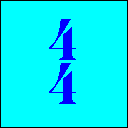 In a Time Signature, the top number gives you the
number of beats per measure and the bottom number gives you the type of note that takes
the beat. The Time Signature is placed at the beginning of the music right after the key
signature. The Time Signature is not repeated at the beginning of each system. It is only
repeated if the Time Signature changes.
In a Time Signature, the top number gives you the
number of beats per measure and the bottom number gives you the type of note that takes
the beat. The Time Signature is placed at the beginning of the music right after the key
signature. The Time Signature is not repeated at the beginning of each system. It is only
repeated if the Time Signature changes.
![]()
Time is perceived in music when a sequence of sounds are held for specific durations. The various note durations combined in harmonic and melodic form is called rhythm. More specific, rhythm is the combination of various measurements of time that shape melody, harmony, phrases and the whole composition.
For most music, the two ingredients that affect rhythm are tempo and meter. Meter is a measurement of music in time where time is divided into groups of pulses as designated by the top number of a time signature. Tempo tells you how fast the music is to be played.
 The time signature defines the meter
in music. The top number, given in simple time, may be in duple,
triple or quadruple time. Simple time may also be combined with
each other to form other complex meters.
The time signature defines the meter
in music. The top number, given in simple time, may be in duple,
triple or quadruple time. Simple time may also be combined with
each other to form other complex meters.
 The bottom number, common
to all time signatures, tells you what note gets the pulse.
The bottom number, common
to all time signatures, tells you what note gets the pulse.
 In compound time, the top
number indicates the number of pulses in a measure. Compound means that three pulses are grouped to make one beat. In simple time, one pulse equals one beat. In compound
time, the top number can be in duple, triple or quadruple time. A compound duple has
six pulses, a compound triple has nine, and a compound quadruple has twelve.
In compound time, the top
number indicates the number of pulses in a measure. Compound means that three pulses are grouped to make one beat. In simple time, one pulse equals one beat. In compound
time, the top number can be in duple, triple or quadruple time. A compound duple has
six pulses, a compound triple has nine, and a compound quadruple has twelve.
HISTORY
Early music (about 900 ad.) could be said to be unmeasured. The division of sounds were equal in duration. Tempo, as we know it, was not introduced until the end of the Renaissance.
By about 1250, six rhythmic patterns, codified as modes, set the motion towards measured music. Ligatures are combinations of two or three note groupings that tells the singer or instrumentalist what rhythmic mode to use. During this time, the Franconians used one of four note signs to measure music: the double long, long, breve and semibreve.
In the fourteenth century, the French adapted signs that simplified measurement in music. Some of these signs remain with us today. These signs were used to group notes into beats much the same way we use the time signature to group notes into beats. By this time, note symbols as we know it have been developed.